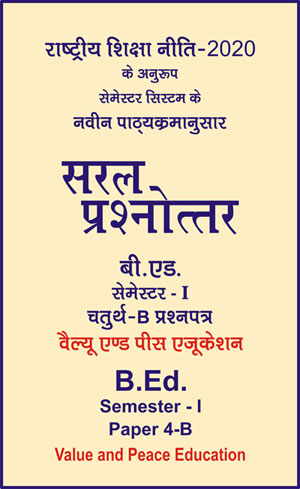|
बी एड - एम एड >> बी.एड. सेमेस्टर-1 प्रश्नपत्र-IV-B - वैल्यू एण्ड पीस एजुकेशन बी.एड. सेमेस्टर-1 प्रश्नपत्र-IV-B - वैल्यू एण्ड पीस एजुकेशनसरल प्रश्नोत्तर समूह
|
5 पाठक हैं |
||||||
बी.एड. सेमेस्टर-1 प्रश्नपत्र-IV-B - वैल्यू एण्ड पीस एजुकेशन (अंग्रेजी भाषा में)
OBJECTIVE TYPE QUESTIONS
For each of the following questions, four alternatives are given for the answer. Only one of them is correct. Choose the correct alternative.
Values Realization
-
Constructive and destructive conflict are distinguished from each other in which of the following ways?
(a) constructive conflict is We-oriented; destructive conflict is Me-oriented
(b) constructive conflict is characterized by de-escalation of the conflict; destructive conflict is characterized by escalation of the conflict
(c) constructive conflict is characterized by cross-complaining; destructive conflict is characterized by flexibility
(d) both a and b -
Constructive and destructive anger can be distinguished from each other by the :
(a) intensity of the anger
(b) flexibility of the anger
(c) duration of the anger
(d) both (a) and (c) -
Which of the following is not a characteristic of conflict?
(a) expressed struggle
(b) independent parties
(c) perceived incompatible goals
(d) perceived interference for outside parties -
Your relationship partner is under a lot of stress lately, and his/her outbursts of anger are beginning to trouble you greatly. Which of the following are ways to manage the anger of your partner?
(a) validate your partner
(b) be asymmetrical
(c) probe
(d) all of the above -
You have continued conflict with your significant other, but you hide it from your friends. This speaks to which dichotomy?
(a) openness/closedness
(b) inclusion/exclusion
(c) revelation/concealment
(d) connection/autonomy -
The process of forgiveness includes which stages?
(a) hating what was done to us
(b) hurting from the wrong done to us
(c) forgetting what was done to us
(d) both (a) and (b) -
Which of the following can be validly concluded from research on inter-cultural conflict management?
(a) collectivist and individualist cultures typically favor different conflict management styles
(b) the key to effective inter-cultural conflict management is flexible use of conflict management styles
(c) disagreement should be discouraged when communicating with individuals from diverse cultures
(d) both (a) and (b)
-
Conflict is :
(a) an unavoidable fact of life
(b) sometimes constructive
(c) a destructive force in relationships if continually avoided
(d) all of the above -
Which of the following is a tactic of avoiding conflict?
(a) competing
(b) stonewalling
(c) autonomy
(d) compromising -
You and your partner have had a heated disagreement. Emotions are raw, and feelings have been hurt. You approach your partner after a brief silence: "I’m sorry I attacked you like that. I got angry and said things I didn’t mean." This is an example of the collaborating tactic called :
(a) integration
(b) confrontation
(c) expanding the pie
(d) smoothing -
In dual concern model the style which represents a low level of concern for both self and other known as ............
(a) Avoiding
(b) Dominating
(c) Obliging
(d) Compromising -
Third party usually helps, clarifies and grounds each disputing party’s alternatives to agreement in ..........
(a) Reality testing
(b) Litigation
(c) Negotiation
(d) Dispute -
A person holds ........ power when he influences others by coercing, threatening, harming and irritating.
(a) Reward
(b) Coercive
(c) Normative
(d) Expert -
Research and investigation can be examples of sources of ........ power.
(a) Expert
(b) Reward
(c) Normative
(d) Democratic -
A dispute between two neighbors can be example of ........ power.
(a) Expert
(b) Reward
(c) Ecological
(d) Social -
Formal power is exercised in a ........ manner.
(a) Bottom-up
(b) Top-down
(c) Horizontal
(d) Vertical -
The influence which is deliberate or purposive in nature may be called ..........
(a) Motivation
(b) Power
(c) Integration
(d) None of the given options -
When one disputant is forced to litigation then .......... style is not possible.
(a) Compromising
(b) Integration
(c) Authoritative
(d) Avoiding -
Dual concern model assumes that no disputant has ........ orientation.
(a) Positive
(b) Negative
(c) Neutral
(d) None of these -
The ........ view states that all conflict should be avoided.
(a) human Relations
(b) interactionist
(c) peace
(d) traditional -
The ............ view suggests that conflict is a natural occurrence in all groups.
(a) interactionist
(b) human relations
(c) performance
(d) traditional -
.......... conflict relates to the content and goals of the work.
(a) Task
(b) Relationship
(c) Process
(d) Functional
|
|||||













